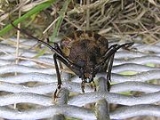
Huhu beetle
Encyclopedia
The huhu beetle, Prionoplus reticularis is the largest endemic beetle
found in New Zealand
, a member of the longhorn beetle
family
(Cerambycidae).
Huhu is now often used as the name for all stages of life of the beetle, but traditionally was the Māori
name for the larva
l stage, which was also known as or . The whitish larvae are up to 70 millimetres (2.8 in) long and feed on dead wood
of more than 14 species of gymnosperm
s and two angiosperms (Acacia
mearnsii and Beilschmiedia tawa). The native host plants are all associated with lowland podocarp
forest.. They are edible, and are said by some to taste like buttery chicken
.
As the huhu reaches maturity it ceases to bore and casts its skin, this still edible stage is known in Maori as . It then develops wings and legs, and while it is still white, it is known as . Finally it emerges and flies off to reproduce and is known as a huhu beetle or to Maori as .
The beetles are most active at night and are attracted by the lights of the dwelling.
Though not usually aggressive, huhu beetles are known to bite when mis-handled.
Beetle
Coleoptera is an order of insects commonly called beetles. The word "coleoptera" is from the Greek , koleos, "sheath"; and , pteron, "wing", thus "sheathed wing". Coleoptera contains more species than any other order, constituting almost 25% of all known life-forms...
found in New Zealand
New Zealand
New Zealand is an island country in the south-western Pacific Ocean comprising two main landmasses and numerous smaller islands. The country is situated some east of Australia across the Tasman Sea, and roughly south of the Pacific island nations of New Caledonia, Fiji, and Tonga...
, a member of the longhorn beetle
Longhorn beetle
The longhorn beetles are a cosmopolitan family of beetles, typically characterized by extremely long antennae, which are often as long as or longer than the beetle's body...
family
Family (biology)
In biological classification, family is* a taxonomic rank. Other well-known ranks are life, domain, kingdom, phylum, class, order, genus, and species, with family fitting between order and genus. As for the other well-known ranks, there is the option of an immediately lower rank, indicated by the...
(Cerambycidae).
Huhu is now often used as the name for all stages of life of the beetle, but traditionally was the Māori
Maori language
Māori or te reo Māori , commonly te reo , is the language of the indigenous population of New Zealand, the Māori. It has the status of an official language in New Zealand...
name for the larva
Larva
A larva is a distinct juvenile form many animals undergo before metamorphosis into adults. Animals with indirect development such as insects, amphibians, or cnidarians typically have a larval phase of their life cycle...
l stage, which was also known as or . The whitish larvae are up to 70 millimetres (2.8 in) long and feed on dead wood
Coarse woody debris
Coarse woody debris is a term used in English-speaking countries for fallen dead trees and the remains of large branches on the ground in forests. Some prefer the term coarse woody habitat . A dead standing tree is known as a snag and provides many of the same functions as coarse woody debris...
of more than 14 species of gymnosperm
Gymnosperm
The gymnosperms are a group of seed-bearing plants that includes conifers, cycads, Ginkgo, and Gnetales. The term "gymnosperm" comes from the Greek word gymnospermos , meaning "naked seeds", after the unenclosed condition of their seeds...
s and two angiosperms (Acacia
Acacia
Acacia is a genus of shrubs and trees belonging to the subfamily Mimosoideae of the family Fabaceae, first described in Africa by the Swedish botanist Carl Linnaeus in 1773. Many non-Australian species tend to be thorny, whereas the majority of Australian acacias are not...
mearnsii and Beilschmiedia tawa). The native host plants are all associated with lowland podocarp
Podocarpaceae
Podocarpaceae is a large family of mainly Southern Hemisphere conifers, comprising about 156 species of evergreen trees and shrubs. It contains 19 genera if Phyllocladus is included and if Manoao and Sundacarpus are recognized....
forest.. They are edible, and are said by some to taste like buttery chicken
Tastes like chicken
"Tastes like chicken" is a common declaration used when trying to describe the flavor of a food a listener has never tasted. The expression has been used so often that it has become somewhat of a cliché...
.
As the huhu reaches maturity it ceases to bore and casts its skin, this still edible stage is known in Maori as . It then develops wings and legs, and while it is still white, it is known as . Finally it emerges and flies off to reproduce and is known as a huhu beetle or to Maori as .
The beetles are most active at night and are attracted by the lights of the dwelling.
Though not usually aggressive, huhu beetles are known to bite when mis-handled.
External links
- Landcare Research - data

